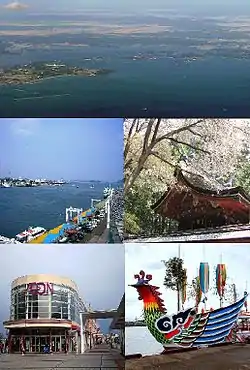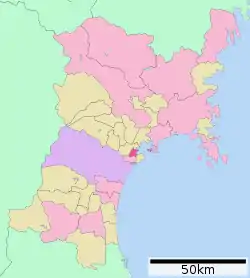Shiogama
Shiogama (塩竈市 or 塩釜市, Shiogama-shi) is a city located in Miyagi Prefecture, Japan. As of 1 June 2019, the city had an estimated population of 52,662, and a population density of 3,032 persons per km² in 23,270 households.[1] The total area of the city is 17.37 square kilometres (6.71 sq mi).
Shiogama
塩竈市 | |
|---|---|
 Urato islands Shiogama Port, Shiogama Shrine Aeon Town Shiogama, Shiogama Port Festival | |
 Flag  Seal | |
 Location of Shiogama in Miyagi Prefecture | |
 Shiogama | |
| Coordinates: 38°18′51.7″N 141°01′19.1″E | |
| Country | Japan |
| Region | Tōhoku |
| Prefecture | Miyagi |
| Area | |
| • Total | 17.37 km2 (6.71 sq mi) |
| Population (June 1, 2019) | |
| • Total | 52,662 |
| • Density | 3,000/km2 (7,900/sq mi) |
| Time zone | UTC+9 (Japan Standard Time) |
| - Tree | Shiogama Sakura |
| - Flower | White Chrysanthemum |
| Phone number | 022-364-1111 |
| Address | 1-1 Asahimachi, Shiogama-shi, Miyagi-ken 985-8501 |
| Website | http://www.city.shiogama.miyagi.jp/ |
Geography
Shiogama is in north-central Miyagi Prefecture, bordered by the Pacific Ocean to the east.
Neighboring municipalities
- Miyagi Prefecture
Demographics
Per Japanese census data,[2] the population of Shiogama has remained fairly stable over the past 40 years.
| Census Year | Population |
|---|---|
| 1970 | 59,772 |
| 1980 | 61,040 |
| 1990 | 62,025 |
| 2000 | 61,547 |
| 2010 | 56,490 |
Climate
Shiogama has a humid climate (Köppen climate classification Cfa) characterized by mild summers and cold winters. The average annual temperature in Shiogama is 12.1 °C. The average annual rainfall is 1225 mm with September as the wettest month. The temperatures are highest on average in August, at around 24.6 °C, and lowest in January, at around 0.8 °C.[3] On January 8, 2021, a minimum temperature of −9.6 °C (14.7 °F) was registered.[4]
Etymology
"Shiogama" means "salt furnace" and refers to a local Shinto ritual involving the making of salt from sea water, still performed every July. The name is sometimes written using the kanji 塩釜 rather than 塩竈 and both spellings are officially permitted. Both 釜 and 竈 are pronounced gama in compounds, but as lone words they are pronounced kama and kamado, respectively. A kamado (竈, "furnace") is a what a kama (釜, "kettle") is placed upon, and so the two are not completely interchangeable. 塩竈 is the form officially used by the city, but for ease of writing, the 10-stroke 釜 is often used in place of the 21-stroke 竈, such as in Shiogama Station.[5]
Shiogama Jinja uses the rendering 鹽竈, with an archaic character for salt. This third form is rarely seen outside of this context.
History
The area of present-day Shiogama was part of ancient Mutsu Province, and has been settled since at least the Jōmon period by the Emishi people. During the Nara period, the area came under the control of colonists from the Yamato dynasty based at nearby Tagajō and was the most important seaport in Mutsu. The ruins of the provincial capital of Mutsu Province have been found within the city borders. During later portion of the Heian period, the area was ruled by the Northern Fujiwara. During the Sengoku period, the area was contested by various samurai clans before the area came under the control of the Date clan of Sendai Domain during the Edo period, under the Tokugawa shogunate.
The town of Shiogama was established with the post-Meiji restoration creation of the modern municipalities system on April 1, 1889. Parts of Tagajō and Shichigahama were incorporated into Shiogama of September 1, 1938. Shiogama was raised to city status on November 23, 1941 (187th, nationally; 3rd in Miyagi). The city annexed the Gyūchi area of neighboring Tagajō on December 1, 1949 and the village of Urato on April 1, 1950.
The city was affected by the tsunami caused by the 2011 Tōhoku earthquake,[6] although damage to its fishing industry turned out to be light.[7]
Government
Shiogama has a mayor-council form of government with a directly elected mayor and a unicameral city legislature of 18 members.
Economy
The economy of Shiogama is largely based on commercial fishing, especially of tuna, and fish processing. The city also boasts of the highest density of sushi restaurants in Japan.
Education
Shiogama has six public elementary schools and four middle schools operated by the city government, and one public high school operated by the Miyagi Prefectural Board of Education.
Transportation
Railway
- East Japan Railway Company (JR East) – Tōhoku Main Line
- East Japan Railway Company (JR East) – Senseki Line
National highways
Miyagi Prefectural Highways
- Miyagi Prefectural Route 3 (Shiogama—Yoshioka)
- Miyagi Prefectural Route 10 (Shiogama—Watari)
- Miyagi Prefectural Route 11 (Shiogama—Shiogama-kō)
- Miyagi Prefectural Route 23 (Sendai—Shiogama)
- Miyagi Prefectural Route 35 (Izumi—Shiogama)
- Miyagi Prefectural Route 58 (Shiogama—Shichigahama—Tagajō)
Local attractions
Festivals
- Shiogama 'Hote' festival (10 March)
- Shiogama Flower festival and Shiogama Citizens Festival (late April)
- Shiogama Harbor festival (Eve: before Marine Day/festival: Marine Day July)
Specialties and crafts
|
|
Visitor attractions

|
|
Notable people from Shiogama
- Masao Maruyama (anime producer) [8]
- Masashi Nakano (politician)[9]
- Nobunaga Shimazaki (voice actor)
References
- Shiogama city official statistics(in Japanese)
- Shiogama population statistics
- Shiogama climate data
- https://twitter.com/extremetemps/status/1347685862021206018
- http://www.city.shiogama.miyagi.jp/seisaku/shise/gaiyo/kamado.html
- http://themes.thestar.com/photo/0eira3V9EGfFA a tsunami wave engulfing vehicles and houses in Shiogama
- Aoki, Mizuho, "Fish processors rise to challenge", Japan Times, 9 April 2011, p. 3.
- Entry at imdb.com
- Official profile
External links
| Wikimedia Commons has media related to Shiogama, Miyagi. |
- Official Website (in Japanese)